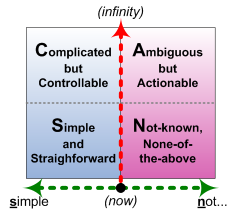SCAN – an Ambiguous correction
Yup, I admit: I got it wrong. (Well, the kind of ‘wrong’ that happens often in early-stage development-work, anyway. 🙂 )
In my initial version of the SCAN sensemaking-framework, I wasn’t happy with the ‘A’ keyword for the ‘not-certain but we do have time to make it sort-of work’ domain (upper-right quadrant). I’d started with Agile, but that’s more about a set of methods that we use in that domain. I’d floundered around with a whole bunch of different keywords, but settled for the awkward ‘Actionable but Awkward‘ because I couldn’t think of anything else.
Courtesy of a blog-post I was reading when a comment from the incomparable Cynthia Kurtz about the previous post came in, this is the all-too-obvious alternative: Ambiguous.
(Duh… I shoulda seen that one much earlier… oh well… [beats self with horse-whip, remembers eventually that all that does is hurt… 😐 dumps horse-whip, gets back to writing…])
More to the point, in another comment, Cynthia shows that it would work better if I switch the statement round:
I love ambiguous. Only I would say it as “ambiguous but actionable” matching your other three as what-it-is then what-you-can-do. And it is perfect that the N-spot does away with what-you-can-do because it’s not that simple there. I also like how you have “but” on the top and “and” on the bottom, which is meaningful.
I hadn’t noticed that distinction between ‘but’ versus ‘and’ – entirely accidental, to be honest – but again, she’s right. It’s only when we have time to argue that we can afford the luxury of ‘but’; when time is compressed to almost-nothing, all we have time for is the improviser’s ‘Yes, and…’.
Anyway, courtesy of those two exactly-to-the-point comments from Cynthia Kurtz, here’s the updated core-graphic:
More posts about how to use this in real-world practice will be coming up Real Soon Now, I promise!
Hope it’s useful, anyway?

I love it that time can stand in for simplicity, which is realistic. Give me ten years and I can work my way into making just about anything work (if it doesn’t kill me first). Give me ten minutes and it had better be simple.
The only thing that bothers me now is the confusion of the word “simple” being in two places. It’s like saying cat sometimes means cat and sometimes means grey cat. Confusing. Which is what you are trying to get away from right?
Also, controllable and actionable are things you can do – you are “able” to do. Straightforward is not, it is a what-it-is. It feels like there should be an “able” word there too, something that speaks to what is possible, what is available.
List of words ending with “able”
http://www.morewords.com/ends-with/able/
scroll to ones starting with “s” – choosing some
scannable
scrutable
seeable
separable
shapeable
solvable
sortable
specifiable
stable
subdivideable
boy do those all look like gibberish after a while 🙂
Favorites:
Straightforward and solvable
Straightforward and specifiable
Straightforward and stable
OR:
simple and solvable
simple and specifiable
simple and stable
and you come up with another word to use on the bottom?
Helpful? Not?
Cynthia – definitely helpful 🙂 – many thanks.
Hmm… more brewing-time, I think? – because you’re right, it isn’t quite right yet, is it? Oh well… Gettin’ close, though… hmm…
Cynthia – thinking about this again overnight, seems likely there’s one key part of this that I haven’t explained properly, namely around how the time-axis actually works. Although it’s useful to do that simple split into two vertical partitions (Simple : Complicated, Not-known : Actionable), it’s actually a completely smooth gradient of available-time-before-decision-on-action: the partition is a Simple abstraction.
One of the real problems we have here is that there’s a heck of a lot of recursion: there’s Simple on both the horizontal and vertical axis because, well, it’s simple; Complicated is out there because it’s not so simple but it’s still Simple in terms of its rule-structure (true/false logic), hence, well, it’s Complicated; and so on.
There’s actually just those two axes: can we use simple true/false logic or do we have to use some modal-logic of possibility; and how much time do we have to decide. Everything else – including the partitioning into ‘domains’ – is an overlay onto that.
Anyway, yeah, will aim to do another blog-post on this later today. Great questions/challenges, though – thanks again!